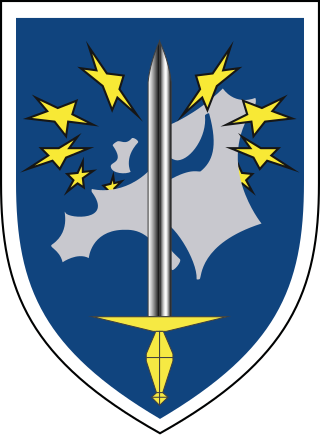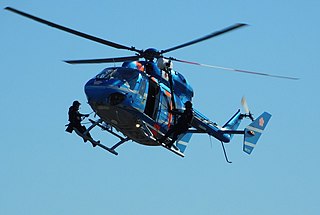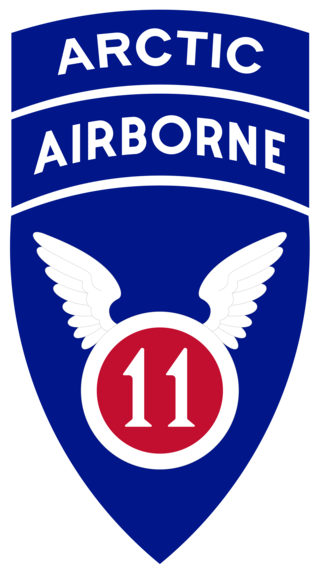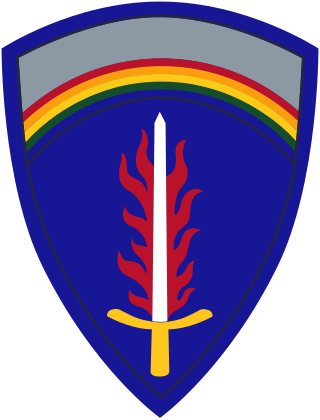History
Creation and early years
The NRF concept was first endorsed with a declaration of NATO's Heads of State at the Prague Summit on 22 November 2002 and approved by NATO Defence Ministers in June 2003. [10] Dual headquarters were created in Naples, Italy and Brunssum, Netherlands; command rotates annually between them. [11] In 2004 and 2005, NRF units were activated for a small number of civilian missions, including to provide security at the 2004 Summer Olympics in Athens [12] and the Afghan presidential elections, [13] as well as to provide humanitarian assistance in the United States after Hurricane Katrina and in Pakistan after the 2005 Kashmir earthquake. [14] Due to equipment shortages, unfulfilled troop commitments and falling political support among member countries, the size of the NRF was cut in half in 2007 and not used again until 2022. [15] During the 2014 Wales summit following the Crimean crisis, NATO leaders agreed to reorganize the NRF's core troops into a "spearhead force" known as a "Very High Readiness Joint Task Force" (VJTF) designed to be able to deploy at 48 hours notice, although the actual level of readiness was generally several weeks. It was also for the first time linked explicitly to NATO's Article 5 obligations. [15] Altogether, it amounted to around 30,000 troops. [16]
For most of its existence, the lack of enthusiasm of NATO's member states for the NRF resulted in chronic equipment and personnel shortages. It was sometimes branded a wasteful failure [17] and an insignificant force next to NATO's more established units. Nevertheless, some military scholars argue that it played a significant role in modernizing European militaries as their troops rotated through it. [15]
2022 Russian invasion of Ukraine
As Russian troops built up around Ukraine in early 2022, various units attached to the NRF were alerted or deployed. On 11 February 2022, a U.S. Army brigade combat team of about 4,700 troops from the 82nd Airborne Division was ordered to Poland, while a Stryker squadron (battalion-sized cavalry unit) was sent from Vilseck's Rose Barracks to Romania. [18] On 11 February 2022 F-35A squadrons of the 388th and 419th Fighter Wings deployed from the U.S. to patrol NATO's eastern flank. [19]
On 16 February 2022, 8,500 troops in some of the units that make up the U.S. contribution to the NRF were put on alert for possible rotational deployment to EUCOM's area of responsibility. [20] [21] By 25 February 2022, 7,000 troops from this force, including the 1st Armored Brigade Combat Team, 3rd Infantry Division — 4700 troops, plus support units), were deployed to Germany. [22] This marked the first time in decades that three U.S. heavy brigades deployed to EUCOM concurrently (the 1st Brigade of the 3rd ID, the 1st Brigade, 1st ID, and an Initial Brigade Combat Team of the 82nd Airborne Division, all to be deployed as needed for the situation). [23] Two forward-deployed headquarters, one from V Corps (United States), and the capability for one from XVIII Airborne Corps, were positioned in Poznan, Poland, [24] [25] and Wiesbaden, Germany [26] respectively, should any further need arise for a proportionate response to a threat to the member states of NATO. [27]
After a NATO meeting on 25 February 2022, NATO Secretary-General Jens Stoltenberg stated that the NATO leadership had agreed to deploy part of the NRF to alliance members in Eastern Europe. Stoltenberg said that Very High Readiness Joint Task Force, currently led by France, would be among the units sent. [28] This was the first time the NRF had been activated for a military mission. [29] In light of the Russian invasion of Ukraine, the NATO Response Force can activate up to 40,000 troops. [30] Eight of NATO's thirty member nations have triggered urgent consultations under Article 4 of the NATO Washington Treaty. [30] In advance of the 2022 Madrid summit, Jens Stoltenberg announced the plan to increase the NRF size to more than 300,000 troops, which was approved during the summit. [3] [31]
It was reported in March 2024 that NRF has already deployed more than 100.000 soldiers in Poland. [32] [33]

The Finnish Defence Forces (FDF) (Finnish: Puolustusvoimat, Swedish: Försvarsmakten) are the military of Finland. The Finnish Defence Forces consist of the Finnish Army, the Finnish Navy, and the Finnish Air Force. In wartime, the Finnish Border Guard becomes part of the Finnish Defence Forces.

V Corps, formerly known as the Fifth Corps, is a regular corps of the United States Army headquartered at Fort Knox, Kentucky and Camp Kościuszko, Poland.

The Supreme Headquarters Allied Powers Europe (SHAPE) is the military headquarters of the North Atlantic Treaty Organization's (NATO) Allied Command Operations (ACO) that commands all NATO operations worldwide. SHAPE is situated in the village of Casteau, near Mons, Belgium.

Eurocorps, located in the French city of Strasbourg (Bas-Rhin), is a multinational corps headquarters. Founded by France and Germany in 1992, it is today composed of personnel from six framework nations and five associated nations. The framework nations place the Eurocorps at the service of the European Union (EU) and NATO, which certified it in 2002 as one of its nine High Readiness Land Headquarters.
The Allied Rapid Reaction Corps (ARRC) is a rapid reaction force maintained by NATO. It is capable of deploying a High Readiness Force (Land) Headquarters at short notice for operations and crisis response.

A rapid reaction force / rapid response force (RRF), quick reaction force / quick response force (QRF), immediate reaction force (IRF), rapid deployment force (RDF), or quick maneuver force (QMF) is a military or police unit capable of responding to emergencies in a very short time frame.

16 Air Assault Brigade Combat Team, known simply as 16 Air Assault Brigade from 1999 – 2021, is a formation of the British Army predominantly based in Colchester, Essex. It makes up the Air Assault Task Force, a battlegroup held at high readiness, and is the only brigade in the British Army focused on operating via parachute, helicopter and air-landing.

The Immediate Response Force (IRF) is a rapid deployment force jointly maintained by the United States Army and United States Air Force, which is capable of deploying worldwide within 18 hours of notification.

The Multinational Corps Northeast was formed on 18 September 1999 at Szczecin, Poland, which became its headquarters. It evolved from what was for many years the only multinational corps in NATO, Allied Land Forces Schleswig-Holstein and Jutland (LANDJUT). From 1962 LANDJUT had been responsible for the defence of the Baltic Approaches from a headquarters at Rendsburg, Germany. It comprised the 6th Panzergrenadier Division and the Danish Jutland Division.

The Rapid Reaction Corps — France (RRC-FR) was created on 1 July 2005 by the French Army. It is NATO certified and capable of commanding a national or multinational land component of between 5,000 and 60,000 personnel. The corps is intended to command forces under French, EU or NATO command. It is subordinated to the French Army's Commandement des Forces Terrestres, the land forces command.
1 German-Netherlands Corps (1GNC) is a multinational formation consisting of units from both the Royal Netherlands Army and German Army. The corps' headquarters also takes part in NATO Response Force readiness rotations. It is situated in Münster, formerly the headquarters of the German Army's I. Corps out of which 1 German-Netherlands Corps evolved. The corps has national and multinational operational responsibilities.

The 2nd Infantry Brigade Combat Team (Airborne), 11th Airborne Division is an airborne infantry brigade combat team (BCT) of the United States Army. The unit is stationed at Joint Base Elmendorf-Richardson in Anchorage, Alaska and is the only airborne brigade combat team in the Pacific Theater. It is also the newest airborne Infantry BCT and one of only five in the United States Army; the others are the three Infantry BCTs of the 82nd Airborne Division and the 173rd Airborne Brigade.

Lithuanian–Polish–Ukrainian Brigade "TLATAS" is a multinational brigade countries of the Lublin Triangle consisting of units from the Lithuanian, Polish and Ukrainian armies. Other countries are free to join the trilateral agreement. An agreement on its creation was signed on November 16, 2009. The brigade was to reach operational status in autumn 2011, but it was delayed; a January 2012 estimate put that date at some time in 2013. The unit was finally formed on September 19, 2014. In July 2015 the defense ministers of the three countries signed an agreement on the operation of the unit.

United States Army Europe and Africa (USAREUR-AF) is an Army Service Component Command (ASCC) /Theater Army responsible for directing United States Army operations throughout the U.S. European Command (EUCOM) and U.S. Africa Command (AFRICOM) area of responsibility.

Operation Atlantic Resolve, refers to military activities in response to Russian operations in Ukraine, mainly the War in Donbass. It was funded under the European Deterrence Initiative. In the wake of Russia's 2014 invasion of Ukraine, the U.S. and the U.K. took several immediate steps to enhance the deterrence posture along the eastern flank of the North Atlantic Treaty Organization (NATO), including augmenting the air, ground and naval presence in the region, and enhancing previously scheduled exercises.

Saber Strike is an annual international exercise held since 2010 by the United States Army Europe (USAREUR) focused on the Baltic States. The exercise spans multiple locations in Lithuania, Latvia and Estonia and involves approximately 2,000 troops from 14 countries.

Enhanced Forward Presence (EFP) is a NATO-allied forward-deployed defense and deterrence military force in Northern, Central and Eastern Europe. This posture in Northern Europe through Estonia, Latvia, and Lithuania and in Central Europe through Poland, Slovakia and Hungary and in Eastern Europe through Romania and Bulgaria, is in place to protect and reassure the security of NATO's Northern, Central and Eastern European member states on NATO's eastern flank.

Headquarters Multinational Division Southeast is NATO's command and control military body in the South-East region under the Multinational Corps Southeast. The operational control is handled by the Supreme Allied Commander Europe (SACEUR). The headquarters are located in Bucharest, Romania. Established on 31 August 2015, the HQ MND-SE is the restructure of the former Romanian 1st Infantry Division.

This article outlines the defence forces of the European Union (EU), which implement the EU's Common Security and Defence Policy (CSDP) in CSDP missions. There are two categories of EU multinational forces: ones that have been established intergovernmentally and made available to the CSDP through article 42.3 of the Treaty on European Union (TEU), such as the Eurocorps; and the EU Battlegroups, established at the EU level.

















